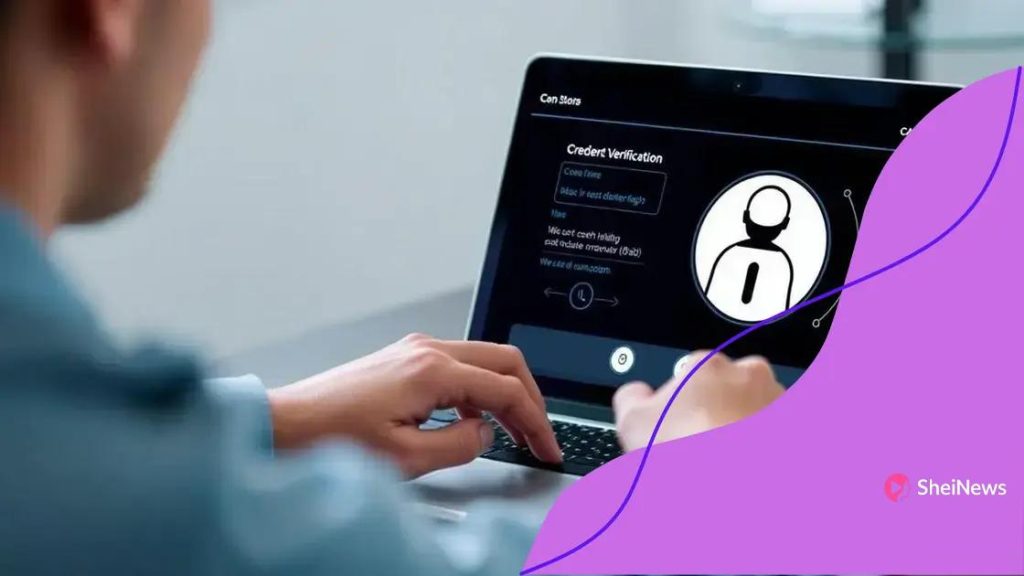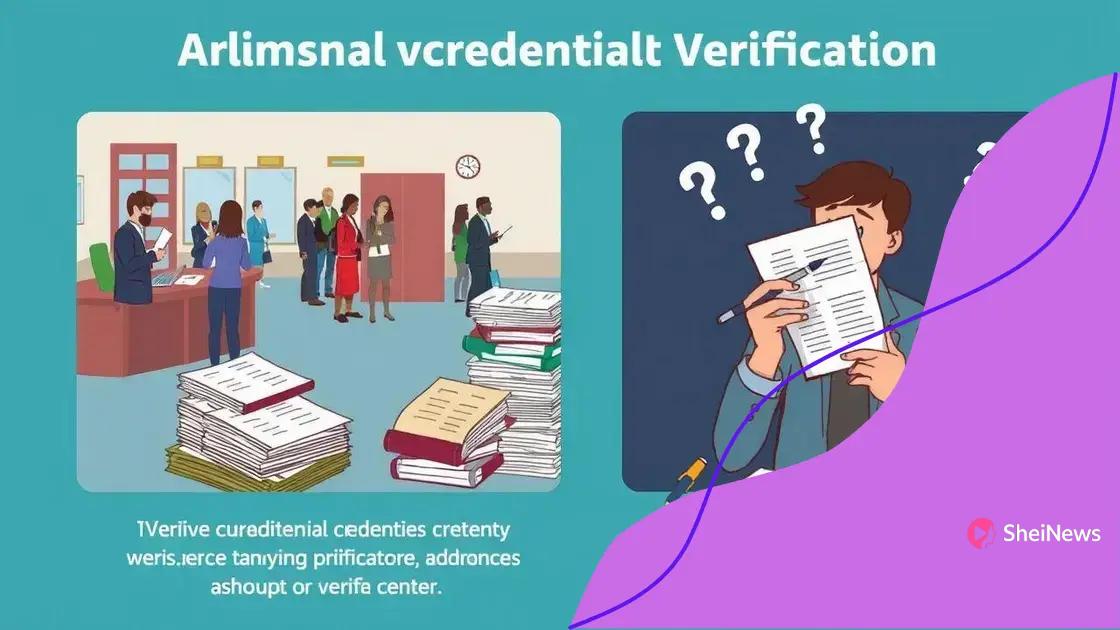Future of verifying educational credentials: What’s next?

Anúncios
The future of verifying educational credentials will be driven by AI and blockchain technologies, streamlining processes, ensuring authenticity, and enhancing the job market through digital credentials.
Future of verifying educational credentials is an evolving landscape that impacts job seekers and employers alike. Have you ever wondered how reliable these verifications are in today’s tech-driven world? Let’s dive into what’s changing.
Anúncios
The importance of educational credential verification
Educational credential verification is vital in today’s job market. It ensures that a candidate’s qualifications are genuine, helping employers make informed decisions.
When employers verify credentials, they want to confirm the integrity of a candidate’s educational background. This process not only protects employers from potential fraud but also fosters fairness among candidates. By verifying credentials, employers ensure that all applicants meet the minimum educational standards.
Benefits of verifying educational credentials
There are several advantages to conducting thorough background checks on educational qualifications:
Anúncios
- Reduces the risk of hiring unqualified candidates.
- Enhances the company’s reputation by hiring only credible individuals.
- Helps in maintaining compliance with industry regulations.
- Builds a trustworthy workplace culture.
Additionally, credential verification is essential in rapidly evolving industries where new technologies and qualifications are constantly emerging. Without proper verification, businesses may struggle to keep up with the necessary skills required. It’s also beneficial for career advancement. Employees with verified credentials tend to receive more job offers and promotions.
Furthermore, educational credential checks contribute to overall workplace quality. They establish a standard of education that aligns with the company’s mission and goals. A well-educated workforce is fundamental to the organization’s success.
In conclusion, the importance of verifying educational credentials cannot be overstated. This practice not only affects hiring decisions but also promotes a culture of honesty and high standards within the workplace. Companies that prioritize verification are more likely to thrive in a competitive market.
Emerging technologies in verification methods
Emerging technologies are transforming the way educational credentials are verified. With advancements in digital solutions, the process has become more efficient and reliable.
One of the leading innovations is the use of blockchain technology. It allows for secure and transparent storage of educational records, making it nearly impossible to falsify credentials. By using a blockchain, institutions can share verified information quickly, promoting trust among employers.
Artificial intelligence in credential verification
Another exciting development is the integration of artificial intelligence (AI). AI can analyze vast amounts of data to detect patterns and inconsistencies in educational claims. This capability enhances the verification process by identifying fraudulent entries that human eyes might miss.
- AI algorithms can determine the credibility of institutions.
- They assist in predicting the employment success of graduates based on their qualifications.
- AI enhances user experience by speeding up the verification process.
Furthermore, digital identity verification tools are on the rise. These tools help confirm an individual’s identity through various means, such as biometric recognition or government-issued IDs. This capability reinforces the integrity of the verification process, ensuring that the right person is recognized for their achievements.
The combination of these technologies makes it easier for employers to verify a candidate’s credentials swiftly. With the ongoing innovation in verification methods, it’s crucial for job seekers to understand how their educational backgrounds can be effectively proven in the job market.
Challenges in traditional credential verification

Challenges in traditional credential verification can create significant hurdles for employers and job seekers alike. Many organizations still rely on outdated verification methods that can be cumbersome and inefficient.
One major issue is the time consumption involved in the verification process. Employers often face delays when trying to confirm educational backgrounds. Contacting educational institutions and awaiting responses can slow down hiring timelines. This inefficiency can lead to missed opportunities for both candidates and organizations as top talent may accept offers elsewhere.
Inconsistencies in educational records
Another challenge is the inconsistency in educational records across different institutions. Not all schools maintain records in the same way. Some may lack proper digital databases, making it hard to access up-to-date information. This inconsistency can lead to confusion and errors during the verification process.
- Some institutions may provide incomplete information.
- Verification methods differ greatly among regions and countries.
- False claims can be difficult to identify without thorough checks.
Moreover, the issue of privacy is a growing concern. Candidates may be hesitant to share personal information, fearing misuse. Employers must navigate this sensitive situation carefully to maintain trust while ensuring they gather the necessary information.
Additionally, traditional verification methods often lack automation, which adds to the challenge. Many organizations still rely on manual checks that can be prone to human error. Automating parts of the process can help streamline workflows, reduce mistakes, and make verification faster.
Impact of digital credentials in the job market
The impact of digital credentials in the job market is profound, reshaping how candidates showcase their skills and qualifications. As technology advances, digital credentials are becoming essential for job seekers aiming to stand out.
Many employers now prioritize candidates with digital credentials. These credentials often include verified online certificates, badges, or e-portfolios that demonstrate skills. This streamlined process allows employers to assess qualifications quickly without traditional delays.
Benefits of digital credentials
There are numerous benefits to using digital credentials:
- Authenticity: Digital credentials can be verified easily, reducing the chance of fraud.
- Accessibility: Candidates have their credentials available at their fingertips, making sharing straightforward.
- Dynamic presentation: Digital formats allow for creative portfolios that highlight individual accomplishments.
Additionally, digital credentials cater to a global audience. Job seekers can apply for positions anywhere without the need for physical documentation. This flexibility empowers candidates to pursue opportunities in diverse markets.
Digital credential systems often integrate with various platforms, allowing for centralized management of educational and professional achievements. This integration helps candidates keep track of their progress and fosters a sense of accountability.
In summary, the shift towards digital credentials signifies a new era in the job market. As more employers recognize their value, candidates must adapt and embrace these tools to enhance their employability.
Future trends in educational verification
The future trends in educational verification indicate a shift towards more streamlined and advanced processes. As technology continues to evolve, new methods will emerge to ensure that candidates’ qualifications are authentic and easily accessible.
One prominent trend is the integration of artificial intelligence (AI) to enhance verification processes. AI can analyze large datasets quickly, allowing for faster identification of discrepancies in educational claims. By automating parts of the verification process, AI not only saves time but also reduces human error.
Rise of blockchain technology
Another significant trend is the use of blockchain technology in credential verification. Blockchain provides a decentralized and secure way to store educational records. This technology eliminates the need for intermediaries, allowing direct verification by employers. With blockchain, once credentials are recorded, they become tamper-proof and can be easily accessed.
- Blockchain can enhance data security and privacy.
- It improves transparency in educational claims.
- Employers gain instant access to verified credentials.
Moreover, the move towards digital credentials is expected to grow. As companies and educational institutions embrace digital solutions, candidates will receive verified certificates that they can share instantly online. This shift not only simplifies the verification process but also allows candidates to showcase their achievements on digital platforms.
Another trend is the growing demand for holistic evaluations. Employers increasingly want to look beyond just educational qualifications. They are focusing on candidates’ skills, experiences, and personal attributes. This broadening of criteria will change how educational institutions prepare students for their careers and how verification processes are structured.
FAQ – Frequently Asked Questions about Educational Credential Verification
What is educational credential verification?
Educational credential verification is the process of confirming a candidate’s educational qualifications to ensure they are genuine and accurate.
Why are digital credentials important?
Digital credentials provide a secure and easily shareable way to present qualifications, making it simpler for candidates to showcase their achievements.
How does blockchain technology improve credential verification?
Blockchain technology ensures that educational records are secure, tamper-proof, and easily accessible, reducing the risk of fraud.
What role does AI play in the future of verification?
AI automates the verification process, speeding up checks and improving accuracy by analyzing large amounts of data efficiently.





